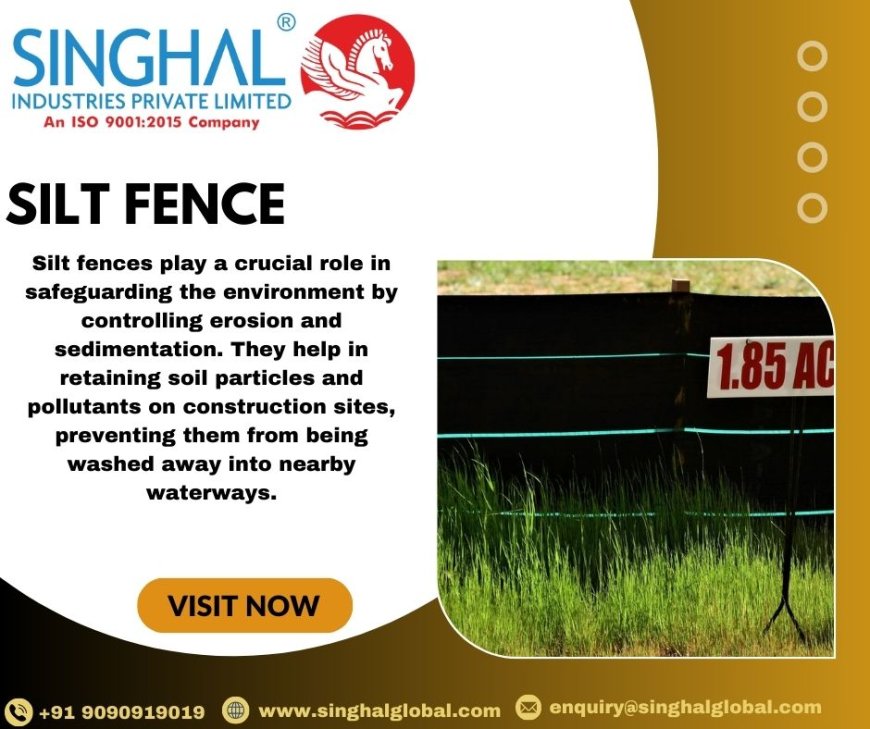Choosing the Right Silt Fence for Your Erosion Control Needs
Choosing the Right Silt Fence for Your Erosion Control Needs

Erosion control is a critical component of construction and land management. Properly managing soil erosion helps prevent sediment runoff into waterways, preserves land integrity, and ensures compliance with environmental regulations. One effective tool for controlling erosion is the silt fence. In this article, we’ll explore how to choose the right silt fence for your needs, focusing on key factors, dimensions, and some common questions related to silt fences.
Understanding Silt Fences
A silt fence is a temporary sediment control device used to manage soil erosion during construction and land-disturbing activities. It consists of a filter fabric attached to stakes that is installed along the perimeter of a disturbed area. As water flows toward the fence, the fabric traps sediment while allowing water to pass through.
Key Factors to Consider
-
Material and Quality
The effectiveness of a silt fence largely depends on the quality of the materials used. Most silt fences are made from woven geotextile fabric, which offers durability and resistance to tearing. It’s essential to choose a silt fence that is UV-resistant to ensure it can withstand prolonged exposure to sunlight without degrading. In India, where climatic conditions can vary, it’s crucial to select a silt fence that is tailored to local environmental conditions. For instance, silt fences provided by reputable Silt Fence Manufacturers like Singhal Industries are designed to meet specific regional requirements.
-
Silt Fence Dimensions
The Silt Fence Dimensions include its height, length, and the spacing of the stakes. Typically, silt fences are available in heights ranging from 18 inches to 36 inches, but dimensions can vary depending on the manufacturer and the specific needs of the project. The length of the fence should cover the entire perimeter of the disturbed area, while the spacing between stakes usually ranges from 6 to 10 feet. It’s important to choose dimensions that suit the scale of your project and comply with local regulations.
-
Installation and Maintenance
Proper installation is crucial for the effectiveness of a silt fence. The fence should be installed with the fabric buried in a trench to prevent water from flowing underneath. Regular maintenance is also necessary to ensure the fence continues to function properly. This includes checking for and repairing any damage, ensuring the fabric remains securely attached, and removing accumulated sediment as needed.
-
Compliance and Regulations
Compliance with local regulations is essential when choosing a silt fence. Different regions have specific guidelines regarding the use and installation of silt fences. For example, in India, regulatory requirements may dictate certain standards for materials and installation practices. Ensuring that your silt fence meets these standards will help avoid legal issues and enhance the effectiveness of your erosion control measures.
Conclusion
Choosing the right Silt Fence in India involves understanding the material, dimensions, installation process, and regulatory requirements. By selecting a high-quality silt fence from a reputable manufacturer like Singhal Industries, you can effectively manage soil erosion and protect your land and waterways. Proper installation and maintenance are also crucial to ensure the silt fence performs as intended. With the right choices, you can achieve effective erosion control and contribute to environmental preservation.
FAQ About Silt Fences
1. What is the purpose of a silt fence?
A silt fence is designed to prevent soil erosion and sediment runoff during construction or land-disturbing activities. By trapping sediment while allowing water to pass through, it helps protect waterways and maintain land integrity.
2. How do I choose the right silt fence for my project?
Consider factors such as the material quality, dimensions, installation requirements, and local regulations. Ensure the silt fence is made from durable, UV-resistant fabric and is sized appropriately for your project.
3. How do I install a silt fence?
Install the silt fence by digging a trench along the perimeter of the disturbed area, placing the bottom of the fabric into the trench, and securing it with stakes. Ensure the fabric is properly tensioned and check for any gaps or weaknesses.
4. How often should I maintain a silt fence?
Regular maintenance is required to ensure the fence remains effective. Check the fence frequently for damage, secure any loose fabric, and remove accumulated sediment to maintain proper function.
5. Can silt fences be used in all types of terrain?
Silt fences are versatile and can be used in various terrains, but the installation approach may need to be adjusted based on the slope and soil type. Consult with a silt fence manufacturer to determine the best type for your specific terrain.
6. Where can I find reliable silt fence manufacturers?
In India, you can find reputable silt fence manufacturers like Singhal Industries, which offer high-quality products designed to meet local requirements and environmental conditions.
Singhal Industries: A Reliable Choice
When selecting a silt fence for your erosion control needs, choosing a reputable manufacturer is key. Singhal Industries is one of the leading silt fence manufacturers in India, known for producing durable and effective silt fences. They offer a range of silt fence dimensions and configurations to suit different project requirements. Singhal Industries is recognized for their commitment to quality and adherence to regulatory standards, making them a reliable choice for anyone needing effective erosion control solutions.
What's Your Reaction?


























